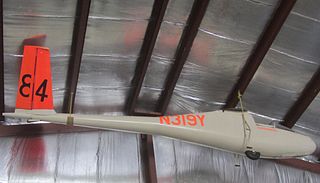Related Research Articles
The Schreder HP-15 sailplane prototype was designed by Richard Schreder as a personal mount in which to challenge the 1969 U.S. National Soaring Championships.
The RS-15 is a Richard Schreder-designed metal Racing Class sailplane that was offered as a kit for homebuilding during the 1970s and 1980s.

The HP-18 is a Richard Schreder-designed metal Racing Class sailplane that was offered as a kit for homebuilding during the 1970s and 1980s.
The Schreder Airmate HP-9 is an American high wing, single seat glider that was designed by Richard Schreder and intended to be flown by the designer in the 1960 World Gliding Championships.

The Schreder Airmate HP-10 is an American, high wing, single seat, FAI Standard Class glider that was designed by Richard Schreder. Airmate was the name of Schreder's design company.

The Bikle T-6 is an American, mid-wing, single seat, glider designed by Paul Bikle and based upon the design of the Schreder HP-14. Even though only one T-6 was built it is noted as the most tested and studied glider with complete data published. It has been used extensively as a comparative reference glider for evaluating other designs during in-flight comparisons.

The Schreder Airmate HP-11 is an American mid-wing, V-tailed, single seat glider designed by Richard Schreder. Airmate was the name of Schreder's design company.
The Schreder HP-12 was an American FAI Standard Class glider designed by Richard Schreder for the 1965 World Gliding Championships.
The Schreder HP-12A is an American homebuilt, mid-wing, V tailed, single-seat glider that was assembled out of various components all designed by Richard Schreder.
The Schreder HP-13 is an American high-wing, single seat FAI Open Class glider that was designed by Richard Schreder.
The Schreder HP-16 is an American mid-wing, single seat, V tailed, FAI Standard Class glider that was designed by Richard Schreder.

The Schreder HP-17 was an American mid-wing, V tailed, single seat, experimental glider designed by Richard Schreder to test a new airfoil section.
The Schreder HP-19 is an American, high-wing, T-tail, single seat glider designed by Richard Schreder.
The Schreder HP-20 is an American, high-wing, T-tail, single seat glider designed by Richard Schreder.
The Schreder HP-21 was an American high-wing, variable geometry, V tailed, single seat motor glider project that was designed by Richard Schreder. None was ever completed or flown.

The Bowlus BZ-1 is an American single seat FAI 15 Meter Class, V-tailed glider that was designed and built by Michael Bowlus.
The Culver Rigid Midget is an American mid-wing, single seat glider that was designed by Irv Culver in 1941. The prototype was constructed by Ray Parker and Bill Bowmar and completed in 1947
The Zauner OZ-5 One-Yankee is an American high-wing, T-tailed, single seat, 15 metre class glider that was designed and constructed by Otto Zauner.
The Haufe HA-G-1 Buggie is an American high-wing, strut-braced, single-seat, glider that was designed and constructed by Bruno Haufe and Klaus Hill, first flying in 1967.
References
- ↑ Sailplane directory Archived 2011-09-28 at the Wayback Machine .
- ↑ Rogers, Bennett: 1974 Sailplane Directory, Soaring Magazine, page 36. Soaring Society of America, August 1974. USPS 499-920
- ↑ Said, Bob: 1983 Sailplane Directory, Soaring Magazine, page 57-58. Soaring Society of America, November 1983. USPS 499-920
| This article about a United States engineer, inventor or industrial designer is a stub. You can help Wikipedia by expanding it. |
| This biographical article related to aviation is a stub. You can help Wikipedia by expanding it. |